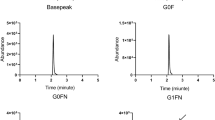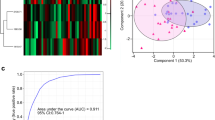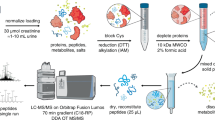Abstract
We applied our 'clinical glycomics' technology, based on DNA sequencer/fragment analyzers, to generate profiles of serum protein N-glycans of liver disease patients. This technology yielded a biomarker that distinguished compensated cirrhotic from noncirrhotic chronic liver disease patients, with 79% sensitivity and 86% specificity (100% sensitivity and specificity for decompensated cirrhosis). In combination with the clinical chemistry–based Fibrotest biomarker, compensated cirrhosis was detected with 100% specificity and 75% sensitivity. The current 'gold standard' for liver cirrhosis detection is an invasive, costly, often painful liver biopsy. Consequently, the highly specific set of biomarkers presented could obviate biopsy in many cirrhosis patients. This biomarker combination could eventually be used in follow-up examinations of chronic liver disease patients, to yield a warning that cirrhosis has developed and that the risk of complications (such as hepatocellular carcinoma) has increased considerably. Our clinical glycomics technique can easily be implemented in existing molecular diagnostics laboratories.
This is a preview of subscription content, access via your institution
Access options
Subscribe to this journal
Receive 12 print issues and online access
$209.00 per year
only $17.42 per issue
Buy this article
- Purchase on Springer Link
- Instant access to full article PDF
Prices may be subject to local taxes which are calculated during checkout





Similar content being viewed by others
References
Staudt, L.M. Molecular diagnosis of the hematologic cancers. N. Engl. J. Med. 348, 1777–1785 (2003).
Wulfkuhle, J.D., Liotta, L.A. & Petricoin, E.F. Proteomic applications for the early detection of cancer. Nat. Rev. Cancer 3, 267–275 (2003).
Hanash, S. Disease proteomics. Nature 422, 226–232 (2003).
Brindle, J.T. et al. Rapid and noninvasive diagnosis of the presence and severity of coronary heart disease using 1H-NMR-based metabonomics. Nat. Med. 8, 1439–1444 (2002).
Callewaert, N., Geysens, S., Molemans, F. & Contreras, R. Ultrasensitive profiling and sequencing of N-linked oligosaccharides using standard DNA-sequencing equipment. Glycobiology 11, 275–281 (2001).
Ashwell, G. & Harford, J. Carbohydrate-specific receptors of the liver. Annu. Rev. Biochem. 51, 531–554 (1982).
Lee, S.J. et al. Mannose receptor-mediated regulation of serum glycoprotein homeostasis. Science 295, 1898–1901 (2002).
Cadranel, J.F., Rufat, P. & Degos, F. Practices of liver biopsy in France: results of a prospective nationwide survey. Hepatology 32, 477–481 (2000).
Menon, K.V. & Kamath, P.S. Managing the complications of cirrhosis. Mayo Clin. Proc. 75, 501–509 (2000).
Kuper, H. et al. The risk of liver and bile duct cancer in patients with chronic viral hepatitis, alcoholism, or cirrhosis. Hepatology 34, 714–718 (2001).
Piccinino, F., Sagnelli, E., Pasquale, G. & Giusti, G. Complications following percutaneous liver biopsy. A multicentre retrospective study on 68,276 biopsies. J. Hepatol. 2, 165–173 (1986).
Imbert-Bismut, F. et al. Biochemical markers of liver fibrosis in patients with hepatitis C virus infection: a prospective study. Lancet 357, 1069–1075 (2001).
Poynard, T. et al. Biochemical markers of liver fibrosis in patients infected by hepatitis C virus: longitudinal validation in a randomized trial. J. Viral. Hepat. 9, 128–133 (2002).
Henderson, A.R. Assessing test accuracy and its clinical consequences: a primer for receiver operating characteristic curve analysis. Ann. Clin. Biochem. 30, 521–539 (1993).
The METAVIR cooperative group. Inter- and intra-observer variation in the assessment of liver biopsy of chronic hepatitis C. Hepatology 20, 15–20 (1994).
Bellentani, S. et al. Prevalence of chronic liver disease in the general population of northern Italy: the Dionysos study. Hepatology 20, 1442–1449 (1994).
Parekh, R.B. et al. Association of rheumatoid arthritis and primary osteoarthritis with changes in the glycosylation pattern of total serum IgG. Nature 316, 452–457 (1985).
Stibler, H. Carbohydrate-deficient transferrin in serum: a new marker of potentially harmful alcohol consumption reviewed. Clin. Chem. 37, 2029–2037 (1991).
Miyoshi, E. et al. Gene expression of N-acetylglucosaminyltransferases III and V: a possible implication for liver regeneration. Hepatology 22, 1847–1855 (1995).
Ishibashi, K. et al. N-Acetylglucosaminyltransferase-III in human serum, and liver and hepatoma tissues — increased activity in liver cirrhosis and hepatoma patients. Clin. Chim. Acta 185, 325–332 (1989).
Sawamura, T. et al. Hyperasialoglycoproteinemia in patients with chronic liver diseases and/or liver cell carcinoma. Asialoglycoprotein receptor in cirrhosis and liver cell carcinoma. Gastroenterology 87, 1217–1221 (1984).
Ise, H., Sugihara, N., Negishi, N., Nikaido, T. & Akaike, T. Low asialoglycoprotein receptor expression as markers for highly proliferative potential hepatocytes. Biochem. Biophys. Res. Commun. 285, 172–182 (2001).
Acknowledgements
N.C. is a postdoctoral fellow with the Fund for Scientific Research Flanders. This work was supported by the Fund for Scientific Research Flanders and by Ghent University (GOA Grant 12052299). The authors thank all blood donors for their participation; B. Vandekerckhove of the Blood Transfusion Center of the Red Cross Ghent and F. Dekeyser of the Department of Internal Medicine of Ghent University hospital for their collaboration; A. Vandeputte for expert technical assistance; A. Bredan for manuscript editing; B. Wuyts and J. Penders for assistance; M. Aebi for making an ABI 310 available for some of our experiments; and the management and technology transfer team of the Flanders Interuniversity Institute for Biotechnology for their encouragement.
Author information
Authors and Affiliations
Corresponding authors
Ethics declarations
Competing interests
There is a patent application (WO 03/087833) connected to this work.
Rights and permissions
About this article
Cite this article
Callewaert, N., Vlierberghe, H., Hecke, A. et al. Noninvasive diagnosis of liver cirrhosis using DNA sequencer–based total serum protein glycomics. Nat Med 10, 429–434 (2004). https://doi.org/10.1038/nm1006
Received:
Accepted:
Published:
Issue Date:
DOI: https://doi.org/10.1038/nm1006
This article is cited by
-
High-throughput N-glycan screening method for therapeutic antibodies using a microchip-based DNA analyzer: a promising methodology for monitoring monoclonal antibody N-glycosylation
Analytical and Bioanalytical Chemistry (2021)
-
Effluent and serum protein N-glycosylation is associated with inflammation and peritoneal membrane transport characteristics in peritoneal dialysis patients
Scientific Reports (2018)
-
N-glycosylation of serum proteins for the assessment of patients with IgD multiple myeloma
BMC Cancer (2017)
-
Metabolic characterization of hepatitis B virus-related liver cirrhosis using NMR-based serum metabolomics
Metabolomics (2017)
-
Validation of N-glycan markers that improve the performance of CA19-9 in pancreatic cancer
Clinical and Experimental Medicine (2017)



